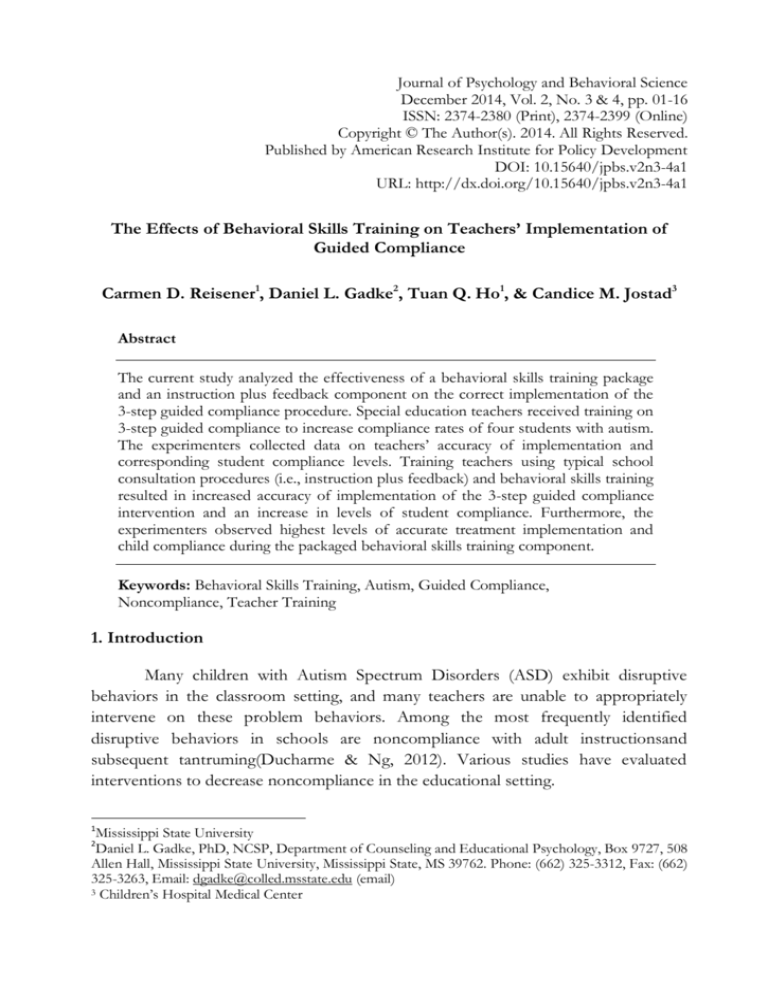
Journal of Psychology and Behavioral Science
December 2014, Vol. 2, No. 3 & 4, pp. 01-16
ISSN: 2374-2380 (Print), 2374-2399 (Online)
Copyright © The Author(s). 2014. All Rights Reserved.
Published by American Research Institute for Policy Development
DOI: 10.15640/jpbs.v2n3-4a1
URL: http://dx.doi.org/10.15640/jpbs.v2n3-4a1
The Effects of Behavioral Skills Training on Teachers’ Implementation of
Guided Compliance
Carmen D. Reisener1, Daniel L. Gadke2, Tuan Q. Ho1, & Candice M. Jostad3
Abstract
The current study analyzed the effectiveness of a behavioral skills training package
and an instruction plus feedback component on the correct implementation of the
3-step guided compliance procedure. Special education teachers received training on
3-step guided compliance to increase compliance rates of four students with autism.
The experimenters collected data on teachers’ accuracy of implementation and
corresponding student compliance levels. Training teachers using typical school
consultation procedures (i.e., instruction plus feedback) and behavioral skills training
resulted in increased accuracy of implementation of the 3-step guided compliance
intervention and an increase in levels of student compliance. Furthermore, the
experimenters observed highest levels of accurate treatment implementation and
child compliance during the packaged behavioral skills training component.
Keywords: Behavioral Skills Training, Autism, Guided Compliance,
Noncompliance, Teacher Training
1. Introduction
Many children with Autism Spectrum Disorders (ASD) exhibit disruptive
behaviors in the classroom setting, and many teachers are unable to appropriately
intervene on these problem behaviors. Among the most frequently identified
disruptive behaviors in schools are noncompliance with adult instructionsand
subsequent tantruming(Ducharme & Ng, 2012). Various studies have evaluated
interventions to decrease noncompliance in the educational setting.
1
Mississippi State University
Daniel L. Gadke, PhD, NCSP, Department of Counseling and Educational Psychology, Box 9727, 508
Allen Hall, Mississippi State University, Mississippi State, MS 39762. Phone: (662) 325-3312, Fax: (662)
325-3263, Email: dgadke@colled.msstate.edu (email)
3 Children’s Hospital Medical Center
2
2
Journal of Psychology and Behavioral Science, Vol. 2(3 & 4), December 2014
These interventions can be classified into two categories: antecedent-based
strategiesand consequent-based strategies(Wilder & Atwell, 2006). However,
antecedent-based interventions such as the high-probability sequence, statements
describing why to follow instructions, warnings, and non-contingent reinforcement
have either shown mixed results or have been proven to be largely ineffective in
decreasing noncompliance (e.g., Ardoin, Martens, & Wolfe, 1999; Cote, Thompson, &
McKerchar, 2005; Rortvedt & Miltenberger, 1994). Likewise, results of studies
employing consequent-based strategies such as positive reinforcement strategies and
time-out from reinforcement have shown mixed results or may not always be
appropriate in the school environment (e.g., Baer, Rowbury, & Baer, 1973; Rortvedt
& Miltenberger, 1994; Weisberg & Clements, 1977).
One strategy that has received increased attention in the behavior analytical
literature as an effective intervention to decrease noncompliance is guided compliance
(Miles & Wilder, 2009), which was first introduced by Horner and Keilitz in 1975.
Although numerous variations of the strategy exist in the literature, the intervention
typically consists of the delivery of gradually more intrusive prompts (i.e., verbal
prompt, model prompt, physical guidance) following the child’s noncompliance to
adult instructions. Several mechanisms may be responsible for the behavior change
that occurs with guided compliance. According to Wilder and colleagues (2012), the
behavioral mechanism of escape extinction used when guided compliance is
implemented may contributeto the decrease in undesirable behaviors demonstrated
with this procedure. With escape extinction in the form of physical guidance, the
child’s attempt to escape or avoid task demands is no longer reinforced; thus resulting
in decreased noncompliance. Another possible reason for increased compliance may
be that the physical guidance component could have functioned as a punisher, thus
increasing compliance rates in participants (Wilder & Atwell, 2006). A third possible
mechanism responsible for the effects of the 3-step guided compliance procedure
may be negative reinforcement in that students are able to avoid physical guidance (or
any further prompt) by complying with task demands. Regardless of the mechanism
responsible for behavior change, guided compliance appears to be a viable
intervention across settings(Wilder & Atwell, 2006; Wilder et al., 2012).
In order to produce the desired effects in the school setting, behavioral
strategies, including guided compliance,must be implemented with high accuracy.
Reisener, Gadke, Ho & Jostad
3
However, special education teachers may be untrained and have greater
difficulty managing disruptive behaviorsin the classroom setting as they lack the
knowledge and skills to effectively handle and decrease these inappropriate behaviors.
Hence, the teachers’ skill deficit may lead to unintentional maintenance of
problematic behaviors in the school setting (Fox, Dunlap, & Cushing, 2002).
One strategy experimenters have used to train parents and stafftoimplement
guided compliance is behavioral skills training (BST). BST employs the combinationof
instruction, modeling, rehearsal, praise, and corrective feedback to teach a specific
skill set (Horner & Keilitz, 1975). Recent studies have examined the effectiveness of
BST to train parents to conduct functional assessments and select effective treatments
(Shayne & Miltenberger, 2013), teach parents to implement guided compliance (Miles
& Wilder, 2009), promote safe and correct guarding responses of staff members
working with children with multiple disabilities (Nabeyama & Sturmey, 2010), teach
staff chaining of vocal behavior for children with autism (Seiverling, Pantelides,
Ruiz&Sturmey, 2010),train special education teachers to conduct discrete-trial
training(Sarokoff & Stormey, 2004), and teach safety skills such as gun-play
prevention skills, abduction prevention skills, and sexual abuse prevention skills (e.g.,
Johnson, Miltenberger, Egemo-Helm, Jostad, Flessner, & Gatheridge, 2005;
Miltenberger, Flessner, Gatheridge, Johnson, Setterlund, & Egemo, 2004).All studies
resulted in the implementation of the interventions with high accuracy, indicating that
BST is an effective instructional package for teaching numerous skills set to various
individuals including parents and teachers.
To date, no study has examined the effectiveness of BST for training teachers
to implement 3-step guided compliancewith children with autism in the special
education environment. Furthermore, few studies have examined both the accuracyof
implementation of BST and the effects on the corresponding child behavior.
Therefore, the purpose of the current study was to extend Miles and Wilder’s (2009)
research to the special education setting, promoting correct implementation of 3-step
guided compliance and increasing compliance rates of four school-aged students with
autism. Additionally, the authors examined whether instructions plus corrective
feedback were as effective in increasing compliance rates in children with autismas the
combined BST package.
4
Journal of Psychology and Behavioral Science, Vol. 2(3 & 4), December 2014
2. Method
2.1 Participants and Setting
Four elementary students and their special education teachers from one rural
school district in the Southeastern United States participated in this study. Inclusion
criteria for the children were as follows: (a) diagnosis of ASD, (b) teacher referral due
to concerns with overall compliance, (c) compliance rates below 50% as measured by
direct observations, (d) Functional Behavior Assessment (FBA) results demonstrating
a function of escape/avoidance for noncompliant behavior, (e) prior behavioral
interventions such as time-out and loss of privileges that had been determined to be
ineffective for noncompliance, and (e) parent and teacher consented to participation.
The first student-teacher dyad consisted of Mitch and his special education teacher.
Mitch was a seven-year-old Hispanic male who attended a self-contained special
education first-grade classroom for all academic instruction. He had been diagnosed
with autism at the age of four. According to his teacher, Mitch had high rates of
noncompliance and tantrum behavior (e.g., crying, flopping to the floor, hitting, and
kicking) when academic demands were placed on him. His special education teacher
was a Caucasian female in her early 30s. It was her first year teaching in a K-3 special
education classroom. She received her special educator’s license through an alternate
route program and had little-to-no experience with working with children with ASD.
Further, she indicated that she did not have intensive training in behavioral
interventions or classroom management strategies. Her classroom consisted of six
students with ASD or Developmental Delays (DD) and one full-time assistant
teacher.
The second dyad consisted of Trevor and his special education teacher.
Trevor was a four-year old Caucasian male who attended a Pre-K classroom for half a
day. He had been diagnosed with autism at the age of three. By teacher report, he
engaged in high rates of noncompliance when given a task. His special education
teacher was a Caucasian female in her mid 50s who had more than 20 years of
experience teaching children with special needs. Additionally, she had obtained a
graduate degree in special education. Her classroom was comprised of six children
between the ages of three and five and two full-time assistant teachers. All students in
the classroom were diagnosed with DD, ASD, or Down Syndrome. According to selfreport, the special educator had significant training in behavioral interventions and
classroom management strategies through previous course work as well as continuing
education credits and in-service trainings.
Reisener, Gadke, Ho & Jostad
5
Savannah and her first-grade inclusion teacher made up the third dyad.
Savannah was aseven-year-old African American female in afirst-grade inclusion
setting. She attended 50% of the day in the regular education environment, while
receiving remedial instruction during the remainder of the school day in a special
education resource room. Savannah had been diagnosed with autism at the age of
four. She was referred to participate in the study by her inclusion teacher due to high
rates of noncompliance and tantrum behavior during classroom instruction and
independent class work. Her inclusion teacher had three years of experience working
in her current position. She was a Caucasian female in her late 20s who was enrolled
in a Master’s program in special education at the time of the study. By self-report,
shehad previous exposure to trainings on behavioral interventions and classroom
management strategies through her graduate school program. The inclusion teacher
was appointed by the special education director to participate in the study due to her
rapport with Savannah.
The last dyad consisted of Beth and her K-3 special education teacher. Beth
was a six-year-old Caucasian female enrolled full-time in a self-contained special
education classroom. She had been diagnosed with pervasive developmental disorder
- not otherwise specified (PDD-NOS) at the age of four. Beth engaged in high rates
of noncompliance and tantrum behavior when given an academic task. Her teacher
was an African-American female in her late 40s who had ten or more years of
experience working in the special education environment. She had received a graduate
degree in special education and indicated intensive training on behavioral
interventions and classroom management techniques. Her classroom consisted of
seven children with a variety of disabilities including ASD, DD, Fetal Alcohol
Syndrome, and mild to moderate intellectual disabilities. Two full-time teacher aides
assisted her during the day.
Intervention procedures for three out of the four students were conducted in
special education classrooms. Savannah was the only student who received
interventions in the regular education setting. The intervention components were
implemented by special education or inclusion teachers and supervised by a
credentialed school psychologist or school psychologists-in-training.
6
Journal of Psychology and Behavioral Science, Vol. 2(3 & 4), December 2014
Further, all experimenters had previously beeninstructed on relevant
procedures and were required to demonstrate proficiency (i.e., meet a masterycriterion
of 100% correct implementation on three consecutive trials) prior to implementing
intervention andassessment procedures.
2.2 Data Collection and Dependent Measures
Data were collected by trained observers in the school setting during
instructional time (i.e., reading, spelling, math, and circle time). Data collection
procedures followed methods used in an earlier study by Miles and Wilder (2009).
However, slight modifications were made to the number of trials per session and
treatment implementation steps of the guided compliance procedure. Sessions in the
current study consisted of 10 trials with the presentation of an academic task demand
by the teacher in approximately 1 min intervals. 3-step guided compliance was used
(i.e., verbal prompt followed by model prompt followed by physical prompt)
contingent upon the child’s noncompliant behavior. All participating teachers were
instructed to first deliver a verbal prompt. Then, if the child did not comply within 10
sec, teachers were trained to repeat the verbal prompt while simultaneously modeling
the correct response and then stating, “You do it.” If the child did not comply within
10 sec, teachers then repeated the task demand verbally while simultaneously
physically guiding (i.e., hand-over-hand) task completion. Contingent praise was
delivered only during successful completion of the task followingthe verbal or model
prompt.
The primarydependent measure was the percentage of the 12 steps of the 3step guided compliance procedureimplementedcorrectly. The percentage of correct
responses was calculated by dividing the total number of steps correctly implemented
by the total number of correct plusincorrect responses for each trial, multiplied by
100. The mean percentage across the 10 trials was graphed as an overall session score.
Reisener, Gadke, Ho & Jostad
7
The 12 steps required by teachers for implementation of the guided
compliance intervention included: (a) requested and made eye contact with the child
before presenting the demand; (b) called the child by name; (c) gave only one task
demand at a time; (d) used calm, neutral tone of voice to deliver the demand; (e) used
a demand, not a question, when delivering instruction; (f) used a specific/descriptive
command; (g) used ‘do’ instead of ‘don’t’ commands (i.e., directive commands); (h)
waited 10 s for child to initiate responding; (i) praised if the child complied or
repeated the demand using modeling(modeling included getting eye contact,
performing the task, and then stating, “You do it”); (j) praised if the child complied or
repeated the demand using physicalguidance for task completion; (k) recorded
compliance data; and (l) waited at least 5 s to present another demand or interact with
the child in some other way. Correct responses were coded if the teacher
appropriately completed a step as outlined above. Incorrect responses were coded
when the teacher implemented steps that varied from themethod mentioned above or
if the teacher omitted a step. The secondary dependent measure was the children’s
percentage of compliance with the task demands. Compliance was coded only if the
children followed through with or initiated the task demand followingthe verbal
prompt (Miles & Wilder, 2009).
2.3 Procedural Integrity and Inter-observer Agreement
To assess procedural integrity, a second researcher observed 33% of the
training sessions between researcher and teacher and independently coded correct
implementation of BST training components by the researcher. Thesecomponents
included: (a) providing verbal and graphic feedback of prior performance; (b)
providing verbal instruction including all 12 guided compliance steps; (c) modeling the
correct responses; (d) prompting the teacher to rehearse the correct responses; (e)
providing feedback based upon rehearsal performance; (f) repeating the previous
steps until the teacher demonstrated 100% correct implementation of the guided
compliance steps during rehearsal. Procedural integrity was scored as a percentage of
correctly implemented BST components. The percentage was calculated by
dividingthe number of BSTcomponents presented by the number of components
presented plus components omitted and then multiplying the result by 100.
Procedural integrity was 100% across all observed sessions.
8
Journal of Psychology and Behavioral Science, Vol. 2(3 & 4), December 2014
To assess inter-observer agreement (IOA), a second researcher observed 33%
of baseline and treatment sessions and independently coded theteachers’
implementation of the 12 guided compliance steps.The percentage agreement was
calculated by dividing the number of agreements by the number of agreements plus
disagreements and multiplying the result by100. The mean IOAfor all participants
across phaseswas 93% (range, 86% to 100%).
3. Experimental Design and Procedures
A nonconcurrent multiple baseline design across teacher-child dyads was used
to evaluate the effectiveness of the BST packageand the instructions plus corrective
feedback component on teachers’ implementation of 3-step guided compliance and
children’s compliance rates.
Baseline. Prior to each baseline session, the researcher instructed the teacher to
deliver an academic task demand to the child. The demands were typically occurring
instructions for the classroom setting (e.g., “Savannah, get out your reading book”).
No specific guidelines were provided to teachers regarding the type of task, difficulty
of demand, or prompting strategy. However, they were asked to provide
approximately one task demand every 1 min during a 10 min session. Teacher and
child behaviors were recorded for each session. The mean duration of baseline
sessions was 7.8 min (range, 6.3 min to 12.7 min).
Instruction plus corrective feedback.The instruction plus corrective feedback
condition closely resembled the consultation approach of school psychologists in the
school setting. During this condition, the primary researcher provided each teacher
with a written description of the 3-step guided compliance strategy, delineating the 12
steps used in the procedure. Immediately following review of the written document,
teachers were given combined visual (i.e., integrity sheet) and verbal feedback on their
baseline performance emphasizing the steps that were missed during
baseline.Following feedback, teachers were then instructed to present academic
demands to a child for a 10-min session. The initial training sessions lasted an average
of 40 min (range, 28 min to 43 min).During all subsequent intervention sessions,
visual and verbal feedback was provided to teachers based upon performance on the
immediately preceding intervention session indicating steps implemented correctly
and steps that needed reviewing. Following feedback, teachers were then instructed to
present academic demands to child for a 10-min session.
Reisener, Gadke, Ho & Jostad
9
None of the remaining feedback sessions lasted longer than 15 min (range, 11
min to 15 min). A graphical display of child compliance rates was also available to
teachers during feedback sessions because child data were displayed on the same
graph as teacher data. Child compliance rates and teacher implementation data were
recorded simultaneously after the initial training sessions.
Behavioral Skills Training (BST). During the BST sessions, the researcher
provided the same first two steps as outlined in the previous section (i.e., written
instructions including the 12-steps of guided compliance and feedback regarding steps
omitted during previous sessions). The researcher modeled the 12-step guided
compliance procedure with a child for five trials. Next, teachers were asked to
rehearse the 3-step guided compliance procedure with the researcher acting as the
child. During rehearsal, teachers engaged in five trials with a child. Immediately after
each rehearsal trial, verbal feedback was provided to teachers based upon their
adherence to the treatment protocol. The researcher indicated which steps were
successfully implemented and which steps had to be reviewed again. The modeling,
rehearsal, and feedback components were repeated until the teacher reached 100%
accuracy in the implementation of 3-step guided compliance across three consecutive
5-trial sessions. Initial training sessions lasted 51-min to 77-min. At the beginning of
each subsequent session, teachers received brief verbal and graphical feedback on
their performance during previous sessions. No other training was provided.
Following feedback, teachers were then instructed to present academic demands to
child for a 10-min session. Child data were collected in the same fashion as during
the previous condition but data collection for the child participants did not begin and
is not reflected graphically until after teachers had attained 100% accuracy of
implementation of the guided compliance procedure.
Follow-up. Maintenance data were collected five weeks after termination of the
BST sessions.During follow-up sessions, procedures were identical to thebaseline
condition.Teachers were asked to provide approximately one task demand every 1
min during a 10-min session while both teacher and child behaviors were recorded.
10
Journal of Psychology and Behavioral Science, Vol. 2(3 & 4), December 2014
4. Results and Discussion
Figure 1 depicts the percentage of correct teacher implementation of 3-step
guided compliance and the corresponding percentage of student compliance rates
across all the phases of the study. For all students, overall compliance rates increased
in both intervention phases relative to baseline performance and were maintained
during the five week follow-up. Highest compliance levels for all four students were
observed during implementation of the BST package. Additionally, all special
education teachers’ implementation of 3-step guided compliance increased in both
intervention phases relative to baseline levels and was also maintained during the five
week follow-up, with percentage of correctly implemented steps being highest during
the BST condition.
During baseline, data for Mitch and his teacher revealed low and relatively
stable levels of child compliance and teacher implementation of 3-step guided
compliance. Mitch was compliant with an average of 15.6% of task demands during
baseline, while his teacher implemented guided compliance with an average of 21.2%
accuracy. When the Instruction plus Feedback intervention was introduced for Mitch
and his teacher, data revealed improvements in both teacher implementation of 3-step
guided compliance and child compliance levels relative to baseline. During this
condition, teacher implementation of 3-step guided compliance showed an immediate
increase compared to baseline levels, and data remained stable throughout this phase.
Mitch’s teacher implemented the intervention with a mean accuracy of 41.6% while
child compliance data were more variable throughout the intervention with an average
of 30.6%. No changes in data were observed for the other participants with the
implementation of the first intervention phase for Mitch.
During the BST package phase, the mean percentage of teacher
implementation of guided complianceincreased to 68.2% and mean student
compliance for Mitchincreased to 47.4%. It should be noted that Mitch was sick
during session 17, leading to 0% compliance and relatively low levels of correct
teacher implementation during that session. Immediately after recovering from the
illness, the percentage of correct teacher implementation of the guided compliance
procedure and child compliance increased to pre-illness levels. No change in data for
the other participants was observed with the implementation of the BST package for
Mitch.
Reisener, Gadke, Ho & Jostad
11
During the five week follow-up for Mitch, both child and teacher data
remained stable, with an average of 63.6% accurate teacher implementation of 3-step
guided compliance and 59% child compliance. Overall, results for this student-teacher
dyad indicated the highest percentages of compliance and intervention accuracy
during the BST condition, with gains maintained at follow-up.
Trevor’s baseline data indicated low and relatively stable levels of compliance
with average child compliance of 15.7%. His teacher’saverage implementation
accuracy of guided compliancewas 34.6%. Following the implementation of
Instruction plus Feedback, mean child compliance and teacher accuracy of
implementation increased immediately to 42.5% and 59.7%, respectively. With
introduction of the BST package, Trevor’s compliance increased to a mean of 72.3%.
During this condition, Trevor’s teacher implemented the guided compliance
procedure with an average of 90.9% integrity. These high levels of performance were
somewhat maintained during the five week follow-up with stable data for both child
and teacher. Trevor’s mean compliance during follow-up was 61.7%, whereas
accuracy of teacher implementation of 3-step guided compliance was 81.8%. Overall,
data for this dyad indicated the highest percentages of compliance and intervention
accuracy during the BST condition.
Savannah’s and her teacher’s baseline data were low, relatively stable, and with
a decreasing trend toward the end of the baseline phase. On average, Savannah
complied with task demands 20.9% of the time during baseline, while her teacher
implemented the interventionwith 35.7% mean accuracy. During the Instruction plus
Feedback condition, the mean accuracy of teacher implementation of guided
compliance was 55.8% and the mean percentage of child compliance was 42.4%.
During BST, Savannah’s teacher implemented 3-step guided compliance with a
meanof 83.9%accuracy, while Savannah complied with a meanof 66.9% of task
demands. Somewhat lower teacher accuracy of implementation was observed during
the five week follow-up, withmean teacher implementation accuracy of 66.6%.
However, child compliance was maintained at follow-up with an average of 68.1%.
Overall, data for this dyad indicated the highest percentages of compliance and
implementation accuracy during the BST condition.
Beth and her teacher also had low and stable baseline data with average child
compliance of 16.3% and average teacher implementation accuracy of 15.6%.
12
Journal of Psychology and Behavioral Science, Vol. 2(3 & 4), December 2014
With the introduction of the Instruction plus Feedback condition, an
immediate increase in level and upward trend for child compliance data was observed
(M = 49.5%), while teacher implementation of the intervention remained relatively
stable with only slightly higher accuracy (M = 23.4%) when compared to baseline
levels. During the BST condition, correct implementation of 3-step guided
compliance and child compliance increased (M = 66.2% and M =70.4% respectively)
relative to the previous condition. Data collected during the five week follow-up
indicated moderate levels of correct implementation of guided compliance as well as
child compliance (M = 45.5% and M = 59.9% respectively). It should be noted that
Beth was the only student whose compliance rates, during all phases but baseline,
were consistently higher than teacher accuracy of treatment implementation.
In summary, the greatest gains in child compliance and accurate
implementation of the guided compliance were observed during the BST condition
for all dyads.For all dyads except Beth and her teacher, increases in accurate
implementation of guided compliance resulted in increases in student compliance.
Additionally, moderate levels of accurate implementation and compliance were
observed during the five week follow-up for all participantswith maintenance data
remaining above baseline levels for all four dyads.
The results of the current study indicate that special education teachers, who
have little to no training in implementation of behavior analytic strategies, can
successfully be trained in a short amount of time to implement 3-step guided
compliance in the school setting to reduce noncompliance in children with autism.
Thus, the current findings support and extend previous research on BST and 3-step
guided complianceby showing that the packed procedure is an effective and efficient
way to train special education teachers while having a positive effect on child
compliance.
Interestingly, anecdotal data suggested that teachers had a difficult time
praising children for appropriate behavior and often failed to deliver clear and concise
task demands.Additionally, Beth’s teacher mentioned on several occasions that she
did not think the intervention had the desired effects, which could have been the
reason for relatively low accuracy in implementation of the 3-step guided compliance
procedure.All other teachers reported a high degree of satisfaction with the
intervention and stated that they would continue to use the intervention with other
children when appropriate.
Reisener, Gadke, Ho & Jostad
13
It is unclear why Beth responded fairly well to the intervention, given that her
teacher was not satisfied with the strategy. Beth is the only student who displayed
improvements in compliance when her teacher’scorrect implementation of the
procedure remained low. One potential reason for the results could have been the
previous training Beth’s teacher had received, as she stated that she had extensive
training in the field of classroom management and behavioral interventions.
Although, no other intervention efforts were directly observed by the experimenters,
data collection only occurred during a small time interval, and it is possible that Beth’s
teacher used other strategies when the observers were not in the classroom that may
have affected Beth’s compliance.
One limitation of the study is that variability in teacher experiences and
previous training in behavior management was not controlled. Additionally, detailed
information was not collected on prior training and experience. Whereas two teachers
(i.e., dyad 1 and dyad 3), self-reported only limited training in behavioral interventions
and classroom management of children with autism, the other two teachers reported
extensive previous training and experiences in these areas. However, it should be
noted that the data did not reflect differences in implementation of the intervention
by teachers. Interestingly, the teacher in dyad 4, who had a master’s degree in special
education and self-reported extensive training on behavioral interventions and
classroom management strategies, showed the greatest resistance to implementation
of the intervention. Future studies should control for teacher experiences and
previous trainings in order to determine their effects onthe implementation of 3-step
guided compliance.
Another limitation of the study is the lack of a detailed component analysis
for the BST packaged intervention. The current study evaluatedonly the combined
strategies of Instruction plus Feedback and the packaged BST procedure. The
selection of these two components was due to the time constraints during school
consultation and the responsibilityof teachers to use evidence-based strategies in the
schools to reduce problem behavior. Future research should address this issue and
evaluate the BST components independently to identify which components are
necessary for producing high levels of accuracy of implementation of the 3-step
guided compliance procedure.
14
Journal of Psychology and Behavioral Science, Vol. 2(3 & 4), December 2014
References
Ardoin, S.P., Martins, B.K., & Wolfe, L.A. (1999). Using high-probability instruction
sequences with fading to increase student compliance during transitions. Journal of
Applied Behavior Analysis, 32(3), 339-351. doi:10.1901/jaba.1999.32-339
Baer, A.M., Rowbury, T., & Baer, D.M. (1973). The development of instructional control over
classroom activities of deviant preschool children. Journal of Applied Behavior
Analysis, 6(2), 289-298. doi:10.1901/jaba.1973.6-289
Cote, C.A., Thompson, R.H., & McKerchar, P.M. (2005). The effects of antecedent
interventions and extinction on toddlers' compliance during transitions. Journal of
Applied Behavior Analysis, 38(2), 235-238. doi:10.1901/jaba.2005.143-04
Ducharme, J.M., & Ng, O. (2012). Errorless academic compliance training: a school-based
application for young students with autism. Behavior Modification, 36(5), 650-669.
doi:10.1177/0145445511436006
Fox, L., Dunlap, G., & Cushing, L. (2002). Early intervention, positive behavior support, and
transition to school.Journal of Emotional and Behavioral Disorders, 10(3), 149-157.
Horner, R.D., & Keilitz, I. (1975). Training mentally retarded adolescents to brush their
teeth.Journal of Applied Behavior Analysis, 8(3), 301-309.
Johnson, B.M., Miltenberger, R.G., Egemo-Helm, K., Jostad, C.M., Flessner, C.,
&Gatheridge, B. (2005). Evaluation of behavioral skills training for teaching
abduction-prevention skills to young children. Journal of Applied Behavior Analysis,
38(1), 67-78.
Miles, N.I., & Wilder, D.A. (2009). The effects of behavioral skills training on caregiver
implementation of guided compliance. Journal of Applied Behavior Analysis, 42(2),
405-410. doi: 10.1901/jaba.2009.42-40
Miltenberger, R.G., Flessner, C., Gatheridge, B., Johnson, B., Setterlund, M., & Egemo, K.
(2004). Evaluation of behavioral skills training to prevent gun play in children.
Journal of Applied Behavior Analysis, 37(4), 513-516.
Nabeyama, B., & Sturmey, P. (2010). Using behavioral skills training to promote safe and
correct staff guarding and ambulation distance of students with multiple physical
disabilities. Journal of Applied Behavior Analysis, 43(2), 341-345.
doi:10.1901/jaba.2010.43-341
Rortvedt, A.K., & Miltenberger, R.G. (1994). Analysis of a high-probability instructional
sequence and time-out in the treatment of child noncompliance. Journal of Applied
Behavior Analysis, 27(2), 327-330.
Sarokoff, R.A., & Sturmey, P. (2004). The effects of behavioral skills training on staff
implementation of discrete-trial teaching. Journal of Applied Behavior Analysis,
37(4), 535-538.
Shayne, R., & Miltenberger, R.G. (2013). Evaluation of behavioral skills training for teaching
functional assessment and treatment selection skills to parents. Behavioral
Interventions, 28(1), 4-21. doi:10.1002/bin.1350
Seiverling, L., Pantelides, M., Ruiz, H.M., & Sturmey, P. (2010). The effect of behavioralskills
training with general-case training on staff chaining of child vocalizations within
natural language paradigm. Behavioral Interventions, 25(1), 53-75.
Reisener, Gadke, Ho & Jostad
15
Weisberg, P., & Clements, P. (1977). Effects of direct, intermittent, and vicarious
reinforcement procedures on the development and maintenance of instructionfollowing behaviors in a group of young children. Journal of Applied Behavior
Analysis, 10(2), 314. doi:10.1901/jaba.1977.10-314
Wilder, D.A., & Atwell, J. (2006). Evaluation of a guided compliance procedure to reduce
noncompliance among preschool children. Behavioral Interventions, 21(4), 265-272.
doi:10.1002/bin.222
Wilder, D.A., Myers, K., Nicholson, K., Allison, J., & Fischetti, A.T. (2012). The effects of
rationales, differential reinforcement, and a guided compliance procedure to increase
compliance among preschool children. Education and Treatment of Children, 35(1),
111-122.
16
Journal of Psychology and Behavioral Science, Vol. 2(3 & 4), December 2014
BL
I+F
BST
Follow-up
Teacher
Child
Percentage Correct
sick
Mitch
Trevor
Savannah
Beth
Sessions
Figure 1: The Percentage of Correct Implementation of 3-Step Guided Compliance
and the Corresponding Percentage of Student Compliance Across Baseline (BL),
Instruction Plus Feedback (I+F), Behavioral Skills Training (BST), and a Five Week
Follow-Up for Mitch, Trevor, Savannah, and Beth









